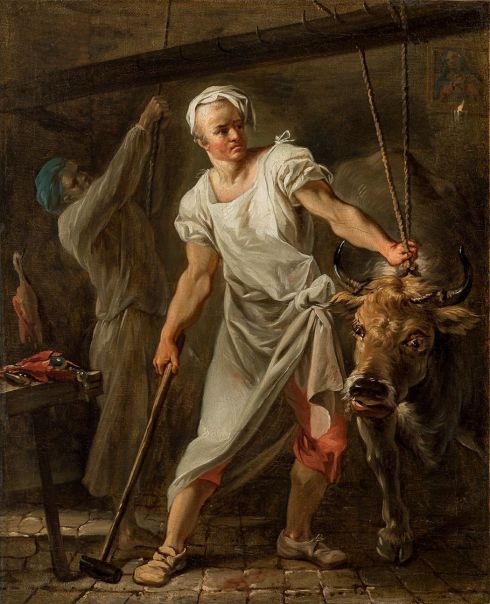Read more
(Paris, 1733 - Versailles, 1796)
The Butcher
Oil on canvas
47 x 38 cm
Provenance :
Sale, Paris, Galerie Charpentier, 5 December 1955, no. 35 (as by François-Guillaume Ménageot). – Sale, Paris, Hôtel Drouot, (C.P.), 12 June 1986, no. 110 (attributed to Jean-Baptiste Marie Pierre), repr. – Paris, private collection.
Literature :
Nicole Willk-Brocard, François-Guillaume Ménageot. 1744-1816 (Paris: Arthena, 1978), p. 63, no. 8, fig. 17.
Anne Leclair, Jacques-Louis Durameau. 1733-1796 (Paris: Arthena, 2001), pp. 186–187, no. P. 118, repr.

Formerly attributed to François-Guillaume Ménageot, then to Jean-Baptiste Marie Pierre, this earthy piece of painting seems to bear the stamp of the singular talent of Louis-Jacques Durameau. The subject fits well with the vigorous temperament of this contemporary of Fragonard, praised during his lifetime for his “masculine drawing” and the “fiery genius of [his] execution”. A pupil of Pierre and Rome Prize laureate in 1757, Durameau found a place on the art scene of his time with big, impassioned allegorical and religious compositions like The Triumph of Justice, now in the courthouse in Rouen, together with the Death of St François de Sales and the Martyrdom of St Cyr and Saint Julitte (Salon of 1767, now in the church of Saint-Nicolas-du-Chardonnet in Paris). At the same time, though, he did not turn up his nose at producing small genre paintings like those of his master.
This picture’s brawny, rough and ready working-class figure – actually a slaughterer – displays affinities with the executioners of the Martyrdom of Saint Cyr (ill. 1, see Leclair, 2001, n° P. 24, p. 131-132): there is the same tension in the facial expressions and the same suspended gestural force in the muscular limbs. Exercised in Paris by the members of a proudly unruly guild, this trade was linked to that of executioner and tended to be shunned under the Ancien Régime.
Despite the precedent provided by Annibale Carracci’s powerful The Butcher’s Shop (Oxford, Ashmolean Museum), this was not a common subject. This painting may have been a private commission, but whatever the case, the situation did not repel Durameau, bent on capturing the stark realism of a genre scene: a burly slaughterer ready to poleaxe a bull which has the lifting tackle tied around its horns. The painter offers a meticulous description of the abattoir, including the pulley for raising the animal and turning it to one side to let the blood drain away, and the hooks from which it is to be hung. He brings the same realism to the traditional leg of lamb and the butcher’s paraphernalia, or “shop” – the pouch for the tools laid out on the table, whose names we find in Part 1 of Diderot’s Encyclopaedia: cleaver, sharpener, lancet, hook, knife.
The simple layout of the composition uses pronounced chiaroscuro to accentuate the whiteness of the butcher’s coarse apron while making play with the cobblestone flooring. In the dimness of the back of the room, where a small candle lights up a framed image of the Virgin, a back-lit butcher’s apprentice reminds us of the freely sketched figures of the Imprimerie secrète (Paris, Fondation Custodia, see eclair, 2001, n° P. 117, p. 184-186, repr).
In closing we should consider the possibility that this slaughterer was a Roman butcher, as indicated by the 1986 sale catalogue. It is not impossible that Durameau executed this painting at the end of his stay in Italy (1764), at around the time of the Martyrdom of Saint Cyr and the Death of Patroclus, in which we find the same stylistic recourse to a form that floods the scene with light. The combination of a highly realistic subject and broad, confident brushwork betrays an urge to react against Boucher’s petite manière. At the same time the close observation of the bull, with its Flemish feel for reality, suggests the explorations of the artist’s contemporaries: Deshayes’ pastorales, for example, and Fragonard’s bull series.
Anne Leclair
Shorten
Read more